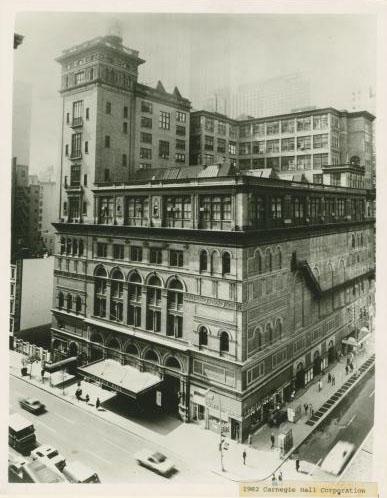 NYPR Archives & Preservation
NYPR Archives & Preservation
The Golden Age of the Carnegie Hall Studios

In the 1960s, a number of New York City’s historic buildings were slated for demolition. Pennsylvania Station was demolished in 1963 to much public outrage, and the original Ziegfeld Theatre followed a few years later. In 1960, Carnegie Hall was threatened with a similar fate when the planned construction of Lincoln Center put the future of the concert hall in jeopardy.
Violinist Isaac Stern’s successful campaign to save Carnegie Hall is legendary. This episode of New York: A Portrait in Sound was produced at a unique time, after the City of New York purchased Carnegie Hall as result of Stern’s 1960 campaign, but before the formation in 1965 of the New York City Landmark Commission, which would honor Carnegie Hall with protective landmark designation in 1967.
The music hall was erected in 1891, and while it was recognized as a world class concert hall, it quickly became clear to Andrew Carnegie, who financed the project, that an alternative source of income would be necessary. The two tower additions were completed in 1894 and 1896 to serve as housing and studio spaces for working artists, with the intention of bringing in additional revenue.
These studios, 170 in all, populated the hall with a lively community of artists. The towers made for a more affordable artistic lifestyle, providing a space where an artist could comfortably both live and practice their craft. There was a ballet studio, which you can hear in the above clip, neighboring an author’s club just down the hall that Mark Twain used to frequent. Painters, poets, photographers and composers lived and worked there.
You can listen to the raw interviews with tenants here, which are featured in the clip above.
In 2007, the city began the process of eviction for the hall’s remaining studio tenants as the Carnegie Hall Corporation moved forward with plans to construct education facilities in their place, and in 2010 the last few residents – poet Elizabeth Sargent, and photographers Bill Cunningham and Editta Sherman – were displaced.
The Resnick Education Wing, which occupies the space these artists once inhabited, is in its inaugural year. Its 24 practice rooms and teaching studios opened in September of last year with the mission of cultivating young talent and their love of classical music.
Much like the famed Hotel Chelsea, also a designated landmark, the Carnegie Hall studios are no longer the mecca for great resident artists they once were, but Carnegie Hall continues to support young artists.
